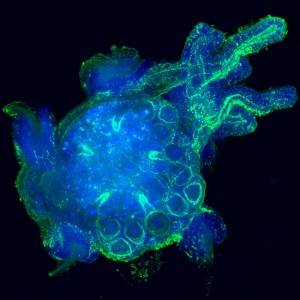Comparative Functional Genomics Lab
Iodine and thyroid hormone function in larval development of sea urchins

One important discovery during my PhD research was that vertebrate-like thyroid hormones (THs) regulate larval development and metamorphosis in sea urchins and sand dollars (Heyland and Hodin, 2004; Heyland et al., 2004;Heyland et al., 2006). These findings raised questions about the signaling mechanisms and synthesis of these and related hormones in echinoids (sea urchins and sand dollars). Recent work from my lab to address TH signaling has focused on iodine (the essential element for TH synthesis and function) uptake, metabolism and signaling in sea urchin embryos and larvae. Ashley Miller, who is in the process of completing her PhD work in my lab (to be completed this fall), discovered a novel iodine uptake mechanism that was so far only known from plants and bacteria (Miller and Heyland, 2010; Miller and Heyland, in press). In collaboration with Stefanie van Bergeijk (IFAPA Centro El Toruño, Spain), we discovered a similar mechanism for iodine uptake in the phytoplankton that sea urchin larvae feed on (Bergeijk et al., in review). This is consistent with and advances the hypothesis that THs or TH precursors are transferred from algae to larvae through feeding (Heyland and Hodin, 2004; Heyland and Moroz, 2005; Miller and Heyland, 2010). In collaboration with Stefanie van Bergeijk and Robert O’Brien (UBC Okanagan) we also made significant progress in measuring THs in phytoplankton and zooplankton samples which led to two additional manuscripts, one of which is currently under review (Bergeijk et al., in review).

More Research in the Heyland Lab





